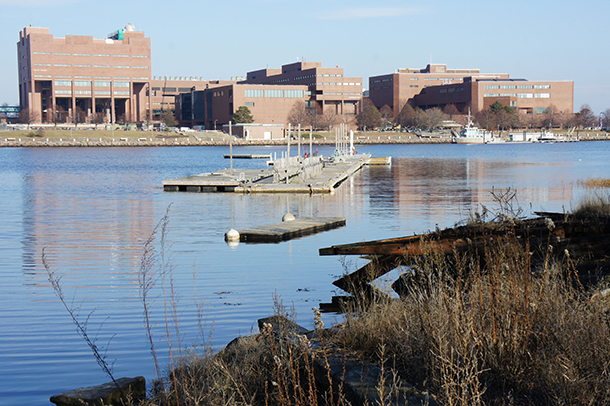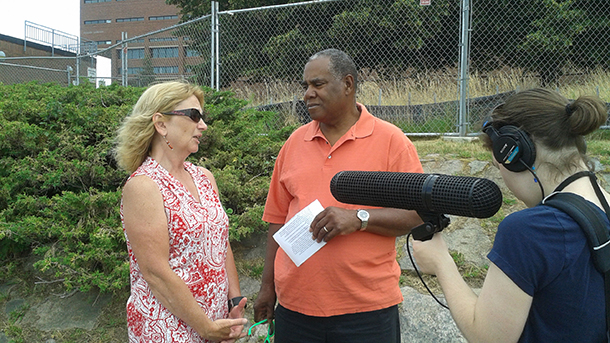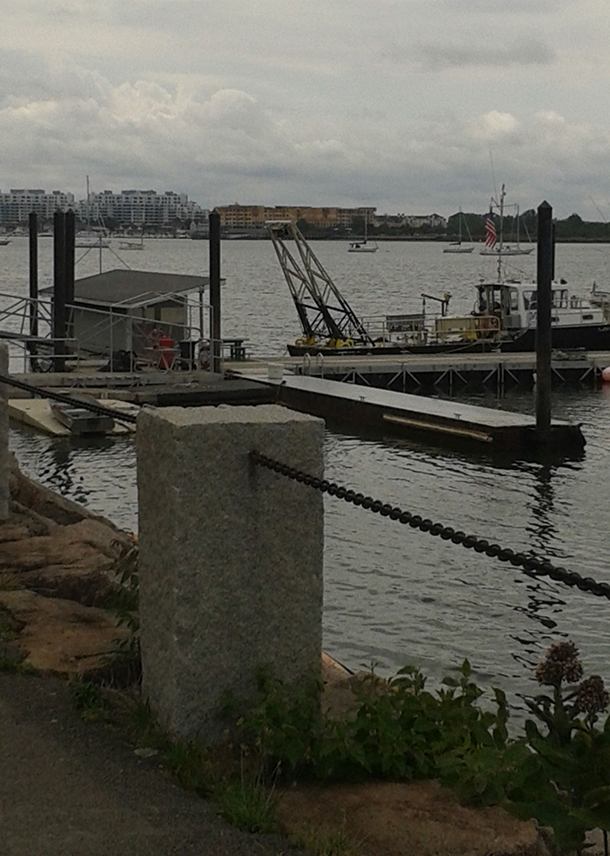Boston in a Warmer World
Air Date: Week of July 29, 2016

UMass Boston’s campus, the home of Living on Earth, is about twenty feet above the high-tide level. (Photo: UMass Boston Photos)
As a port city with low-lying areas, Living on Earth’s hometown of Boston, Massachusetts is particularly vulnerable to the sea level rise anticipated from global warming. So the City of Boston is arming itself with knowledge. The Mayor has commissioned a team of experts called Climate Ready Boston to report on future climate impacts. By the harbor’s edge at the University of Massachusetts’ Boston campus, hydrology professor Ellen Douglas and host Steve Curwood discuss the alarming implications of the report that she and an interdisciplinary group of academics put together.
Transcript
CURWOOD: It’s Living on Earth. I’m Steve Curwood, and we’re in our frontyard, or maybe our backyard, because here at the University of Massachusetts, where we are in Boston, we are on Boston Harbor. And joining us right now is UMass Boston Professor Ellen Douglas. She's a hydrologist who's been studying what would happen to the city of Boston as climate change advances. Welcome to Living on Earth.
DOUGLAS: Thanks. Happy to be here.
CURWOOD: First, tell me, what inspired local leaders to form the team that’s called Climate Ready Boston?
DOUGLAS: Well, it’s been a long time in coming. The city has been working on climate change adaptation and mitigation for a while, but in 2012, when Sandy really devastated New York City, it made a lot of people in Boston realize that we dodged the bullet and that we need to make sure that we're prepared for the event, if something like that happened here.
CURWOOD: So, you have a good size team, what, 20 of you who’re working on this project at various institutions. Talk to me about the disciplines that they bring to the table.
DOUGLAS: Yeah, we had quite a variety. It was really, really quite exciting and very educational too, to work with all these people. We had oceanographers, we had climatologists, we had meteorologists. we had hydrologists, we had engineers, oh, atmospheric scientists, climate scientists, economists. We had people working in consulting firms. We had people from Harvard and Northeastern and Boston University, all the local universities. The list is almost endless. (LAUGHS.)
CURWOOD: Because I guess this touches every part of society.
DOUGLAS: It does. It does. It’s not even just the physical sciences. It’s the social sciences and the economics, as well.
CURWOOD: So here we are, on the edge of the Harbor in Boston. Now, I'm told that the campus itself is almost 20 feet above sea level, the main buildings, but of course we're down on the walkway by the boats, where, oooh, when the tide is up, it’s got to be just six feet away from us. Okay, Ellen, you can tell us. (SHE LAUGHS.) What would happen if Sandy had come here to Boston? What would it be like for us out here at this campus, this harbor?

Hydrologist Ellen Douglas gives Living on Earth host Steve Curwood the bad news about the anticipated climate impacts that lie ahead for the city of Boston, as Jenni Doering records. (Photo: Helen Palmer)
DOUGLAS: Well, while we were standing on the harbor walk, we probably would've gotten feet wet. Campus itself, as it exists right now, amazingly is above even the highest of the scenarios that we looked at, as far as water levels; however you wouldn’t be able get on or off campus because all of Harbor Point area and Morrissey Boulevard entrance would be completely submerged, so it would be kind of like an island at that point.
CURWOOD: So let's get out of our backyard. Talk to me about the bad news here. How much sea level rise is projected in Boston in the coming decades? What are we looking at for the city as a whole?
DOUGLAS: Well, at about mid-century we could be looking at anywhere from, you know, six inches, eight inches up to a foot or so. What really is troubling is towards the end of the century, where we could see anywhere from four to seven feet or as much as ten feet sea level rise. You know, that's the maximum estimate, assuming all possible things go wrong the same time, but still, you know, that's, that's a lot of water.
CURWOOD: So people who’re curious about what that would do the Boston and want to see this visually can go to our website loe.org and see the wonderful map that you guys put together,or I should say maybe it’s a terrifying map. But for folks who are listening, just describe what happens to Boston, say, with 10 feet of sea level rise.
DOUGLAS: 10 feet of sea level rise, you end up with South Boston flooded, the financial District flooded, and the Charles River dam can be over-topped or short-circuited so that water gets back behind it into Back Bay and Cambridge, so a very large part of the city that's not used to getting wet would be wet.
CURWOOD: And I imagine, as a hydrologist you’ve looked at other places that have dealt with this. I’m thinking, of course, of Holland, I’m thinking of the part of the Netherlands that's underwater already and other places in the world.
DOUGLAS: Yeah, well, actually as part of the Climate Ready Boston, interestingly enough, they sent a contingent of people from Boston to the Netherlands, to Denmark, to those communities who have been dealing with this kind of issue for centuries to get some ideas and some suggestions and advice.
CURWOOD: Now, there’s more to climate change than just rising sea level, of course. We're recording this just a summer is really starting to heat up, and in your report you say the summers are already getting hotter here in Boston, so how much hotter is hotter, and what kind of heat is ahead?
DOUGLAS: The average temperatures, I think, are going to go up eight to ten degrees. What really is troubling is the number of days above 90 degrees and above a hundred degrees that we're just not used to hear in the northeast. Typically days above 90 degrees, we get about 11 a year, and by the end of the century, under the highest emission scenario, that could be as many as almost 90 days a year which is like a full summer’s worth of heat wave.

Light blue areas on this map show the parts of Boston that could be innudated under five feet of sea level rise. (Photo: produced using NOAA’s Sea Level Rise tool at https://coast.noaa.gov/slr/)
CURWOOD: Over how many degrees?
DOUGLAS: 90 degrees.
CURWOOD: Oh, my.
DOUGLAS: Yah, heat extremes are a big concern as well as sea level rise.
CURWOOD: I was going to say, people die when it gets that hot. In Chicago, for example, in a heat wave not so long ago, people died.
DOUGLAS: Yah, and it's not even just the number of days, but it's the number of consecutive days, so after about three to five days, you know, cooling systems actually they just can't keep extracting the heat, and so a lot of air conditioning systems begin to not work as well and as efficiently, and it's a real concert health-wise when you're looking at that kind of temperature.
CURWOOD: Water, heat, this is not a positive scenario.
DOUGLAS: No, sad to say, it’s not.
CURWOOD: So, what about other eastern seaboard cities? How much trouble do they face from climate disruption compared to Boston, do you think?
DOUGLAS: Well, pretty much everybody along the coast, they're facing similar issues. Here in Boston in some ways we have an advantage because we have a very high tide range. So it’s a 10 foot tight range, so a lot of our infrastructure is built for this big range. In New York City their tide is only like four feet, two feet up and two feet down, and so that's why when you got a big storm surge on top of their minimal tide range, it really caused a lot of devastation. Here, if a five foot storm surge hits in Boston, which is our extreme storm at low tide, we might not even notice. And that all depends on where you are on the coastline.
CURWOOD: So we’d better not have a full moon and high tide when the next big storm surge comes.
DOUGLAS: (LAUGHS.) Yeah, that's exactly what happened in New York City. The highest high tide and a record storm surge hit at exactly the same time.
CURWOOD: Tell me, why is it important to engage with the Office of the Mayor here on the issue of climate change in Boston?
DOUGLAS: Well, they’re the movers and shakers, right? He’s the one that makes the proclamation that says, “This is a priority for Boston,” and tries to bring people in line, and when you’ve got them on your side it’s a lot easier to get things done.

Savin Hill Cove borders the UMass Boston campus (Photo: Helen Palmer)
CURWOOD: So Boston is about 400 years old. In another 400 years, is there a Boston as we know it?
DOUGLAS: Well, not as we know it, for sure. It’s hard to say, I mean, even in another 200 years there could be parts of Boston that are under water, and so you have to deal with that either by putting up some sort of protective barriers or building buildings higher or whatever, but it's definitely not look like it does today.
CURWOOD: Your task force is moving ahead to prepare a vulnerability assessment and look at some resilience strategies. How do you put that together?
DOUGLAS: Well, the teams that are working on that right now have done a lot a lot of data mining, looking at reports and data that are already existing, to pull it together, integrating it into the strategy that the city wants to take. A big part of it is outreach to communities, to figure out what they're most worried about, and bring in not just city itself but the agencies like Massport, MBTA, Mass DOT, and all the agencies are, are figuring out how their infrastructure is going to be impacted, how their operations are going to be impacted, and it's a matter of figuring out how you're going to work that into the long-term plan. We have time, which is the good news. We have some vulnerability now, but the agencies have time to integrate this into their long-term planning as far as upgrading their infrastructure or building new infrastructure for protection and for flood-proofing, things like that.
CURWOOD: In the immediate future what do you think’s the biggest risk of a climate event here?
DOUGLAS: Probably a big coastal storm. I mean, we're right here on the coast, and not so much a hurricane -- we don't get hurricanes as often as you think -- but a big nor'easter like we saw in ’91, you know, the no-name storm or the perfect storm? That actually caused the largest storm suge we’ve seen, so that's probably the most likely in combination with a lot of precipitation.
CURWOOD: So this is not so much the future but really now.
DOUGLAS: Yuh, yuh, I think we're seeing that pretty much everywhere in the country and the world.

Ellen and Steve spoke on the UMass Boston Harborwalk by Savin Hill Cove (Photo: Helen Palmer)
CURWOOD: How many folks understand that this is an emergency and that people need to move, not just fast, but really fast?
DOUGLAS: Yeah, that is a challenge. We’ve thought of climate change as this long term impact, but observations over the last decade have showed us that, yes there’s long-term impacts, but there's also impacts that are occurring now and things are happening faster than we expected so that is a challenge. And I guess nature sort of helps us out in that way, if you can think of it that way, by, you know, all the flooding and the Superstorm Sandys and things like that definitely get people’s attention.
CURWOOD: For example, right now as we're talking here in Boston, there are wildfires in, I don't know how many states, so it's pretty intense right now.
DOUGLAS: Well and the thing that’s striking is the number of times you hear “record-breaking,” and, you know, statistically speaking, records will always be broken, but the time between records is supposed to increase, but records are being broken over and over and increasingly faster, and so that's what makes realize that the climate is changing, too, is because everything that happens seems to be a record event.
CURWOOD: Professor Ellen Douglas teaches hydrology at the University of Massachusetts Boston. Ellen, thanks so much for taking the time today.
DOUGLAS: Oh, this is fun. Thank you.
Links
Read the Climate Projections Consensus on anticipated climate impacts in Boston
Living on Earth wants to hear from you!
Living on Earth
62 Calef Highway, Suite 212
Lee, NH 03861
Telephone: 617-287-4121
E-mail: comments@loe.org
Newsletter [Click here]
Donate to Living on Earth!
Living on Earth is an independent media program and relies entirely on contributions from listeners and institutions supporting public service. Please donate now to preserve an independent environmental voice.
NewsletterLiving on Earth offers a weekly delivery of the show's rundown to your mailbox. Sign up for our newsletter today!
 Sailors For The Sea: Be the change you want to sea.
Sailors For The Sea: Be the change you want to sea.
 The Grantham Foundation for the Protection of the Environment: Committed to protecting and improving the health of the global environment.
The Grantham Foundation for the Protection of the Environment: Committed to protecting and improving the health of the global environment.
 Contribute to Living on Earth and receive, as our gift to you, an archival print of one of Mark Seth Lender's extraordinary wildlife photographs. Follow the link to see Mark's current collection of photographs.
Contribute to Living on Earth and receive, as our gift to you, an archival print of one of Mark Seth Lender's extraordinary wildlife photographs. Follow the link to see Mark's current collection of photographs.
 Buy a signed copy of Mark Seth Lender's book Smeagull the Seagull & support Living on Earth
Buy a signed copy of Mark Seth Lender's book Smeagull the Seagull & support Living on Earth

